It’s difficult to be enthusiastic about 1938, a year in which England was on the brink of World War II. The policy of appeasement, led by Prime Minister Neville Chamberlain, was in full swing. Aimed at preventing war by making concessions to Nazi Germany, the Munich Agreement was signed at the end of September that year, allowing Germany to annex the Sudetenland, a region of Czechoslovakia. However, this act of appeasement only served to embolden Adolf Hitler. Meanwhile, everyday life was largely characterized by typical pre-war activities, such as listening to the radio and going to the cinema. Yet, under the surface, there was a growing sense of tension and unease as the threat of war loomed ever closer.
Only weeks prior to Munich, my grandparents and father’s annual motoring holiday took them to Lincolnshire, destination Skegness, an ideal seaside destination given my father was in his seventh year.
Lincoln Cathedral
En route, they broke the journey at Lincoln, 43 miles short of the North Sea coast via the A158. Lincoln’s Cathedral is a prominent example of Gothic architecture, renowned for its Norman arch and 13th-century screen. The cathedral’s origins date back to 1073, when Bishop Remigus initiated its construction. However, an earthquake in 1185 largely destroyed the original structure. Under the supervision of Bishop Hugh of Avalon, reconstruction began, with the east transepts and choir being rebuilt between 1174 and 1210. Additional features, including the Galilee Porch, Central Tower, and the Angel Choir, were added between 1215 and 1280.
The cathedral was once home to the world’s tallest building, the central spires, which have since been destroyed. Inside, visitors can marvel at the Judgement Portal, featuring Christ accompanied by elaborately carved angels. Outside, notable structures include the Priory Gate and a statue of Alfred Tennyson who was born in Lincolnshire in 1809.
The cathedral was commissioned by William the Conqueror six years after his victory at the Battle of Hastings. Also early in his reign, King William invited the Jews of Rouen to England to act as district tax collectors and financial administrators. One of the resulting communities settled in Lincoln.
The cathedral was completed in 1092 and has undergone multiple reconstructions following various catastrophes, including the earthquake and a hurricane in 1549 that led to the collapse of the spire. Notably, the cathedral contains few biblical images in its windows. The main entrance is the West Front, but the main door is reserved for certain dignitaries, with visitors typically entering through the Nave.
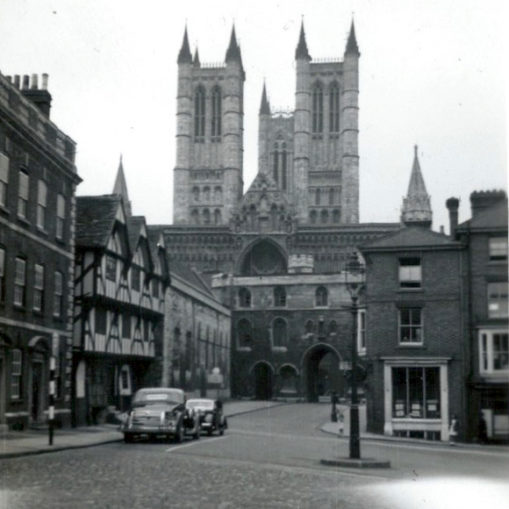
© Always Worth Saying 2023, Going Postal
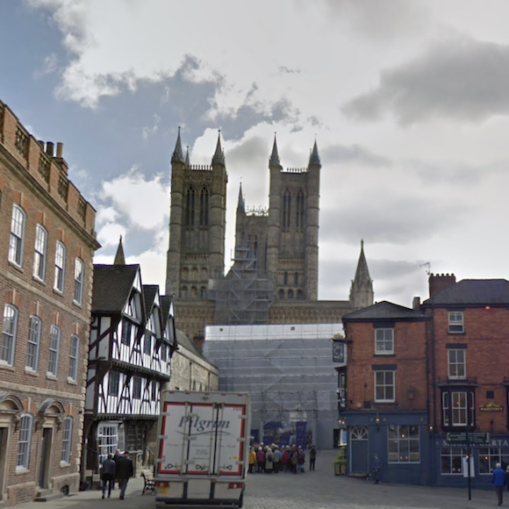
© Google Street View 2023, Google.com
In the old photograph, we view the west entrance to the cathedral with Lincoln Castle a stone’s throw along a cobbled street behind the photographer. Two small girls in skirts stand about a street corner. In the modern day, the view would be similar if not obstructed by scaffolding and a van. Cobbles have replaced the tarmac through the archway. If you think a door has been added to the shop on the corner, not so. The door is angled with the corner, noticeably so on a Street View walkabout. Nearest the cathedral and to the left is the parish church of St Mary Magdalene. Closer to the camera, the mock Tudor building (given the locale, more likely a genuine Tudor building) is a visitor information centre. To the right, in the modern day, licenced premises and a fine art gallery occupy the old buildings.
The Saints Hugh of Lincoln
As for Bishop Hugh, he was to become St. Hugh of Lincoln, an influential figure in 12th-century England. Known for his reforming zeal and commitment to the rule of law, he was born in 1140 in Avalon, France, joined the Carthusian order and became a monk. In 1186, King Henry II appointed him as the Bishop of Lincoln making him one of the most powerful men in the land. St. Hugh was renowned for his fervent faith, dedication to the Church, and his works of charity. He was also a staunch advocate for justice, even daring to rebuke the King for his treatment of the Church. He died in 1200 and was canonized in 1220. Hugh was also prominent through his attempts to protect Lincoln’s Jews from persecution at the beginning of the reign of Richard I as, in 1190, the Jews of Lincoln had been attacked by returning Crusaders.
Decades later, Lincoln gained a second saint, venerated as such although never canonised nor recognised by the Catholic Church. Little Saint Hugh of Lincoln was a young English boy born around 1246. He mysteriously disappeared on July 31, 1255, when he was likely nine years old. His body was later discovered in a well. Hugh had been seen playing with Jewish boys, and his body was found on a property owned by a Jew named Copin. Subsequently, over 90 Jews were arrested, sent to the Tower of London and charged with practising ritual murder. Eighteen were hanged.
A 13th-century certainty that Jews killed Little Hugh has been replaced by a 21st-century certainty that they didn’t. The sign next to the murdered boy’s cathedral shine confers victimhood elsewhere. No matter, in 1290 King Edward I expelled the Jews from England. At the time there were 62 Jewish households documented in Lincoln.
Sandringham
Sixty miles in the other direction from Skegness lies the irresistible day trip destination of the Sandringham estate. The estate covers about 20,000 acres, including lush gardens, farmland, and woodland. The main house, Sandringham House, has been the private home of four generations of British monarchs. The estate is also famous for hosting the Royal Family’s traditional Christmas celebrations. The main house is renowned for its stunning architecture and beautifully maintained gardens. Sandringham House is also significant as the place where King George V and King George VI passed away.
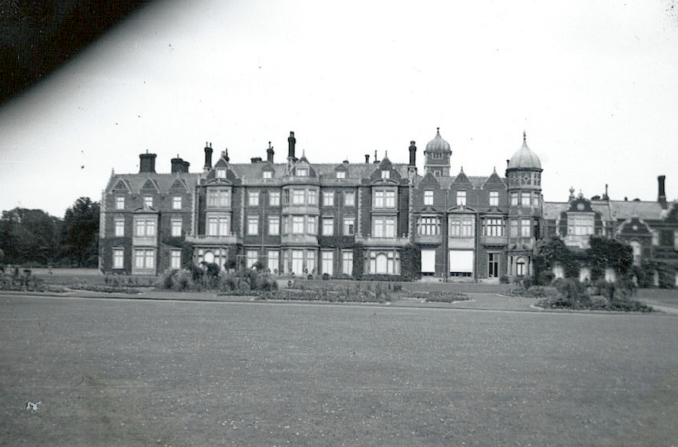
© Always Worth Saying 2023, Going Postal

© Google Street View 2023, Google.com
Sandringham House is a Georgian mansion with roots reaching back to the Elizabethan era. It was bought by John Motteux in 1836. However, the real transformation happened when it was purchased by Queen Victoria in 1862 for £220,000, intending to use it as a country home for her eldest son Prince Albert Edward and his future wife, Princess Alexandra of Denmark. The house and estate underwent extensive reconstruction in the late 19th century, embracing a Jacobean style. The main part of Sandringham House was completed in 1870, and new guest and staff accommodation were added in the 1890s. It was first opened to the public in 1908, followed by the museum in 1930.
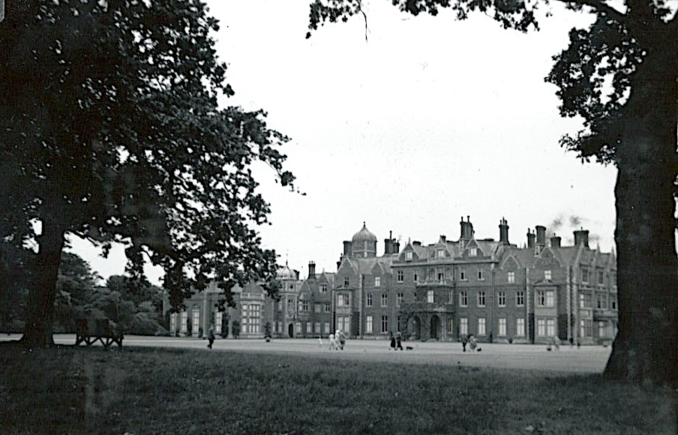
© Always Worth Saying 2023, Going Postal

© Google Street View 2023, Google.com
In 1975, Prince Phillip initiated modernisation efforts, leading to a significant portion of the house’s service wing being demolished. The house was eventually opened to the public in 1977 by Queen Elizabeth II. Today, it remains a beloved retreat for the Royal Family and a popular tourist destination.
York Cottage
York Cottage is a royal stately home situated within the grounds of Sandringham House. Originally known as the Bachelor’s Cottage, it was built as an overflow residence for Sandringham House and later gifted by the future King Edward VII to his son Prince George, the Duke of York, as a wedding gift in 1893. George V and his wife, Queen Mary, lived there for 33 years with the king affectionately referring to its architectural style and ambience as if ‘three Merrie England pubs joined together.’ Today, it serves as the estate office for Sandringham, with part of the building also being used as holiday accommodation and flats for estate employees. Notably, it was expected to be gifted to Prince Harry and Meghan Markle as a wedding present, to allow them the privacy they crave from media attention.
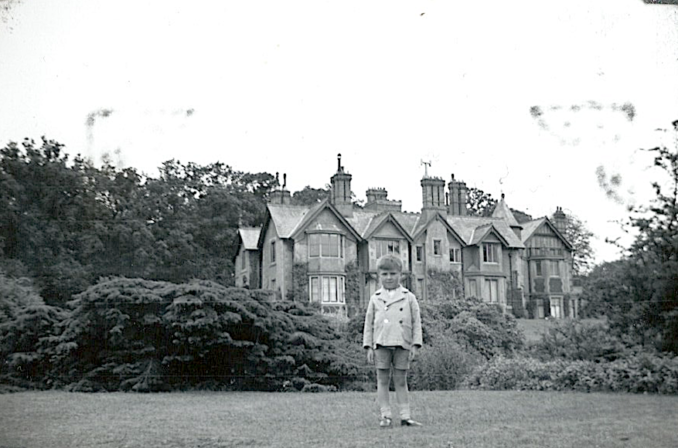
© Always Worth Saying 2023, Going Postal
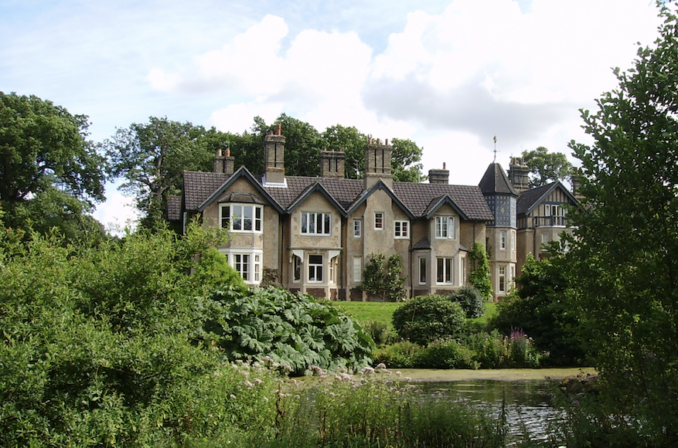
York Cottage, taken in August 2007,
The Giant Puffin – Licence CC BY-SA 3.0
My father is pictured above outside York Cottage in his very best break-bread-with-royalty Sunday best. Meanwhile, in the South of France…
The British Royal Family in 1938
The British Royal Family in 1938 was headed by King George VI, who had ascended to the throne in 1936 after his elder brother Edward VIII abdicated to marry Wallis Simpson, an American divorcée. George VI was married to Queen Elizabeth (later known as the Queen Mother), and they had two daughters, Princess Elizabeth (the late Queen Elizabeth II) and Princess Margaret. The family was known for their dedication to public service amidst the looming threat of World War II, and King George VI was highly respected for his resilience despite his struggles with a stammer.
In 1938, Edward VIII, by then known as the Duke of Windsor, was living a life quite different from that of his past. Having abdicated the throne of the United Kingdom and the emperorship of India the previous year to marry Mrs Simpson, he was now navigating life as a royal without a crown. His relationship with Simpson had begun in 1930 and by 1934 he was deeply in love with her, a sentiment that eventually led to his abdication on December 10, 1936.
Following their marriage on June 3, 1937, his younger brother, George VI, granted him the title Duke of Windsor. However, the new Duchess of Windsor was not extended the rank of “royal” based on the advice of the cabinet.
In the summer of 1938, the Windsors were navigating the Med. The logbook of Greek millionaire Nicholas Zographos’ luxury yacht, the Frixos, tells of the couple’s visits to the likes of Cannes, St Tropez, Monte Carlo, Antibes and the island of Sainte-Marguerite. While war with Germany loomed, the former king and his wife welcomed friends aboard, walked their dog along sun-kissed beaches and were dropped off to dine at exclusive waterfront restaurants along the Riviera.
Quite a contrast to Skegness, but before we rush to judge the Windsors with their Continental ways and wandering loyalties, there is a matter closer to home that I must confide to you.
To be continued…
© Always Worth Saying 2023


